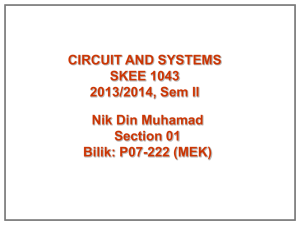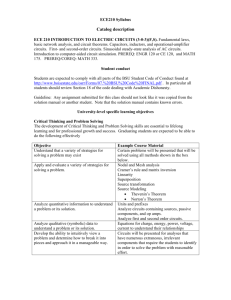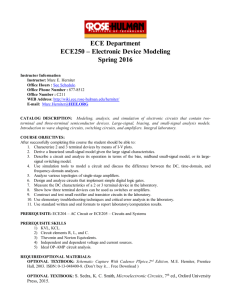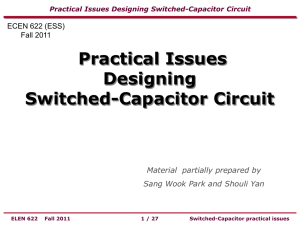course description - Electrical and Computer Engineering
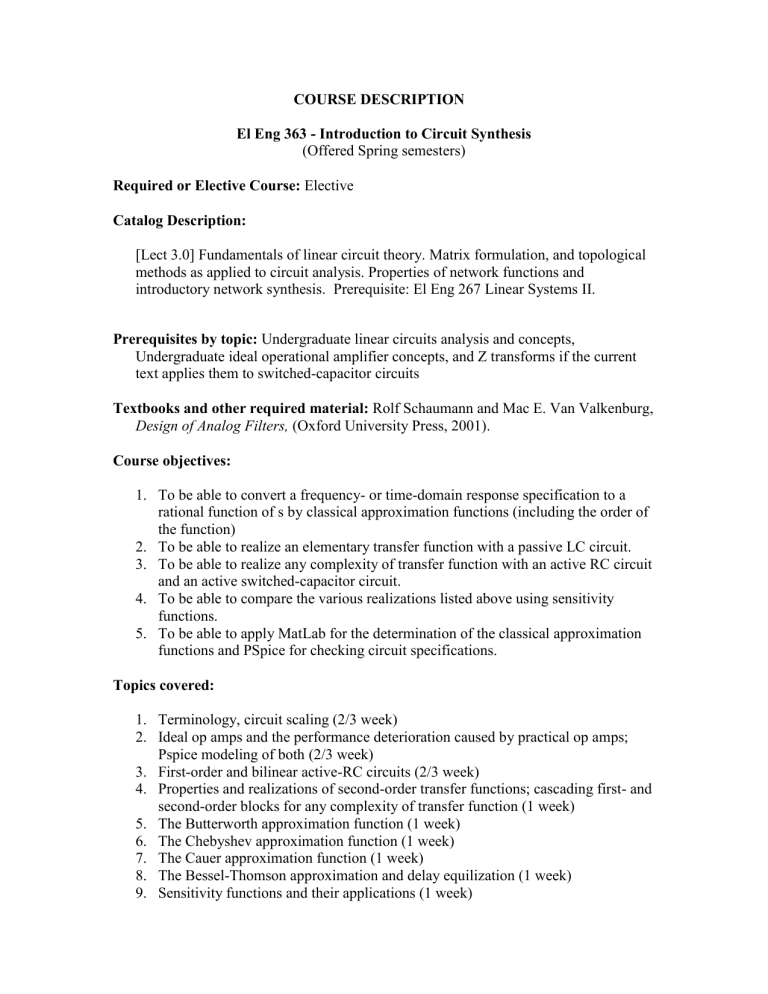
COURSE DESCRIPTION
El Eng 363 - Introduction to Circuit Synthesis
(Offered Spring semesters)
Required or Elective Course: Elective
Catalog Description:
[Lect 3.0] Fundamentals of linear circuit theory. Matrix formulation, and topological methods as applied to circuit analysis. Properties of network functions and introductory network synthesis. Prerequisite: El Eng 267 Linear Systems II.
Prerequisites by topic: Undergraduate linear circuits analysis and concepts,
Undergraduate ideal operational amplifier concepts, and Z transforms if the current text applies them to switched-capacitor circuits
Textbooks and other required material: Rolf Schaumann and Mac E. Van Valkenburg,
Design of Analog Filters, (Oxford University Press, 2001).
Course objectives:
1.
To be able to convert a frequency- or time-domain response specification to a rational function of s by classical approximation functions (including the order of the function)
2.
To be able to realize an elementary transfer function with a passive LC circuit.
3.
To be able to realize any complexity of transfer function with an active RC circuit and an active switched-capacitor circuit.
4.
To be able to compare the various realizations listed above using sensitivity functions.
5.
To be able to apply MatLab for the determination of the classical approximation functions and PSpice for checking circuit specifications.
Topics covered:
1.
Terminology, circuit scaling (2/3 week)
2.
Ideal op amps and the performance deterioration caused by practical op amps;
Pspice modeling of both (2/3 week)
3.
First-order and bilinear active-RC circuits (2/3 week)
4.
Properties and realizations of second-order transfer functions; cascading first- and second-order blocks for any complexity of transfer function (1 week)
5.
The Butterworth approximation function (1 week)
6.
The Chebyshev approximation function (1 week)
7.
The Cauer approximation function (1 week)
8.
The Bessel-Thomson approximation and delay equilization (1 week)
9.
Sensitivity functions and their applications (1 week)
10.
Properties and realizations of elementary passive LC ladder circuits (1 week)
11.
Op-amp simulation of LC ladders (2 weeks)
12.
Transconductance-C circuits (1 week)
13.
Switched-capacitor circuits (2 week)
Class/laboratory schedule:
Three 50-minute or two 75-minute lectures/week are typical.
Contribution of course to meeting the professional component:
This course ties together a number of loose ends of the undergraduate core curriculum embracing several different but related areas.
It provides a unique experience in the creative side of electrical engineering: synthesis as compared to analysis.
It is extremely practical for the newly graduated electrical engineer.
It is provides a strong foundation for further graduate work in this area.
Relationship of course learning outcomes to ECE program outcomes:
ECE
Outcome a b
1
Course Outcomes
2 3 4 5
S S S S M
M M M M S
Comments c d e S S S S
M
S
Applications are linked to fundamental knowledge f g h i W W W W M Tools for lifelong learning. j k M M M M S l
S – strong connection; M – medium connection; W – weak connection
Prepared by: Steve E. Watkins Date: February 1, 2008



